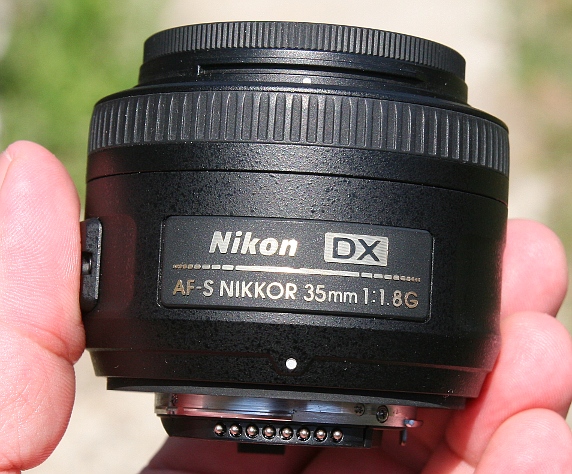Nikon 35 1.8 review
Nikon 35 1.8 G Dx review
Last update: 11/11/2015
Separate sample image page coming soon.

Nikon 35 1.8 G DX
Technical datas – Nikon 35 1.8See more detailed specs at the bottom of the page. Compatibility: Dx, can be used in crop-mode on Fx as well |
Format:
Dx (Aps-C size camera app 23.5*15mm) but can be used on Full frame cameras as well, I saw it even on a D3.
[do_widget Text]
Introduction – Nikon 35 1.8 review
Until now I used only Canon gear, but even that times I thought about to use this lens even on my Canon camera with an adapter. This lens has a very good value. This lens is a ‘no brainer’ : if you need it, and has a budget for it, buy it. This is a normal lens for a “DX” camera. It means that this lens has the same field of view what we see normally with our eyes at center portion, not when we strech it. To be precise a little narrower, because 33mm is normal lens focal length on the 1.5x crop sensor. In film era most photographer used 50mm lenses on their film cameras, which is similar than this 35mm in field of view. If you not sure which focal length you need, I mostly use the lenses at 10-20mm for landscape and general photography, 85mm for portraits, 280-600mm for wildlife, this 35mm is most fit to close portraits, street photography and occasional landscapes. If I not shoot wildlife which I do most of the time, or macro, I mainly want to make landscapes about everything I see everywhere, and for this the 35mm on crop sensor is not the best(little narrow see the picture above). To understand what this lens does is the key to evaluate if you want this lens or not. I have a friend who is happy with a single 50mm on a crop sensor camera, and the 35mm is significantly wider.
[do_widget Text]
Why is this lens is so special:
Two reasons: price and optical quality. Most 50mm lenses are starts to get sharp at f/4. This lens is very sharp at f/2.8, even quite sharp at f/1.8, very sharp in the center. Compare to normal f/3.5 kit lenses this lens lets almost 2 times of light in the image sensor, which results in 4 times shutter speed. Other very nice feature of the lens is the compact size and very light weight which is just very enjoyable. You can bring the lens everywhere without any problem or pain, which is not like this with many other lenses. As a prime lens the framing is not automatic, it needs careful preparation for each shot, we “zoom with our feet”.
Build quality:
The lens has good but not professional build quality with manual focus override and silent auto focus. This is not like those all-metal older manual focus Nikkors, the lens is made of plastic with a metal lens-mount. But I would say for the price it is no reason to complain. The plastic construction helps to keep the weight of the lens low. The 200g is very nice. The lens has no distance scale, which would be useful. If we turn the manual focus ring, there is no hard stops the lens can turn over, but little different to turn.
Optical qualities:
The lens is sharp at almost every apertures, little softer at f1.8 and perhaps at the really small apertures because of diffraction. According to my judgement perfectly usable even at f/1.8, which is not the case for many f/1.8 lenses.
Distortion:
there is some barell distortion of the lens, around 2.5%. This is not the best you can get from a prime lens, but not too disturbing either.
Vignetting or light falloff (darker corners):
the lens is reasonably good for vignetting, everywhere well under 1EV, the most big wide open as usual.
Chromatic aberration:
there is some chromatic aberration, little wide open at f/1.8, most pronounced around f/4-f/5.6 aperture settings, in jpg newer cameras automatically correct it. I wouldn’t think this is a significant problem.
Bokeh
 Nikon 35mm 1.8 at f/1.8 Nikon D7000
Nikon 35mm 1.8 at f/1.8 Nikon D7000
Bokeh or out of focus blur: Bright lenses has a capability of making blurred background, which is hard with the kit lenses. The amount of blur are depend on several factors: how close is the subject (when it is closer better is the bokeh), how bright is the lens (brighter are better) and focal length (longer are better). The bokeh makes pictures special in several ways: helps to emphasize the subject, and blur the unwanted background, the other way is helps to make the image more 3D like. Usually digital photos are 2D pictures: there is no sense of depth of the photo. It is most obvious when we make a drastic landscapes, at the place usually what we see is much more 3D like. In this bokeh can help to give some kind of 3D likeness. Longer lenses usually produce more smooth buttery like bokeh, wider lenses usually makes more fuzzy ones. This 35mm is more like a wide angle lens, the bokeh is not so smooth like with 85mm or longer lenses, but still increase the lens creative potential see the bicyle back little below. Some lenses can produce better looking out of focus highlights (more round), but I think at this level this lens is good enough.
How to focus in dark environment
I read many people mention autofocus operation as a con for this lens. In low light this is how I use the lens. In my Nikon d7000 camera, I switch to live view and manual focus, and use magnified view simply by pressing the + button. Lot of magnification possible here, which helps in precise focusing.
Otherwise yes the autofocus especially in low light not so reliable as with pro grade lenses. This is it, we cannot change it. If I carefully focusing I can nail focus, but if I want to make pictures quickly no guarantee that the focus is in a correct position.
See samples below
Aperture f1.8

Aperture f2.0

Aperture f2.2

Aperture f2.5

Aperture f2.8
as sharp as it gets, on paper slight improvements until f5.6

Price/performace ratio:
Perhaps the best bang for the buck in the whole Nikon lineup. The 35mm wide angle makes it much more useful than the 50mm lenses.
Pros:
-f/1.8 brightness,
-sharp almost all apertures,
-not so expensive compare to the optical qualities,
-small,
-light,
-good focal length,
-full time manual focus override
-52mm non-rotating filter, which means filters are cheaper
Cons:
none really, it is not a premium product in terms of build quality, not full metal, there are smoother manual focus on more expensive lenses.
-no distance scale
-af is not pro grade, especially in low light situations
Sample pictures:

Bicycle back Nikon d5200 with Nikon 35/1.8 DX iso 160, f1.8

Nikon 35 1.8 f3.2 Nikon d5200 exceptional detail

Parliament building , Nikon 35/1.8 Nikon D5200 f/5.6
|
|
|
Nikon 35mm f/1.8 detailed specification
Item |
Nikon 35mm f/1.8 G |
Mount: |
Nikon F mount |
Filter size: |
52 mm |
Lens elements / groups: |
8 / 6 |
Exotic Lens elements: |
1 aspherical lens element |
Weight: |
200 g. ( oz. ) |
Dimensions: |
70 x 52.5 mm (2.76 x 2.07 ” ) |
Close focus distance: |
0.3 m ( 1′) |
Autofocus: |
Yes, HSM |
Stabilizer: |
No |
Front element rotates: |
No |
Moving barrel elements during focusing: |
No |
Constant physical size: |
Yes |
Focus preset modes: |
No |
Switches: |
MF – AF switch |
Lens Mount: |
Metal |
Lens Body: |
Plastic |
Filter thread: |
Plastic |
Format: |
Dx |
Magnification: |
0.16 x |
Reproduction ratio: |
1:6 |
Aperture blades: |
7 rounded diaphragm blades |
Distance scale: |
No |
Infrared index : |
No |
(FTM) Full time manual focus override: |
Yes |
Focal length: |
35 mm |
Max Aperture: |
f/1.8 |
Min Aperture: |
f/22 |
Angle of view: |
44.8° on DX (63° of FF but this is a Dx lens) |
Focus limiter: |
No |
Tripod mount ring: |
No |
Lens hood: |
Nikon HB 46, bayonet lens hood, barrell shaped |
Accessories: |
52mm Snap-on lens cap, LF-1 rear lens cup, CL 0913 soft case, HB 46 lens hood |
Coating : |
Nikon super integrated coating |
Tilt / shift: |
No |
